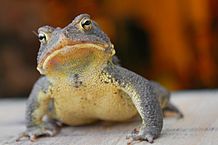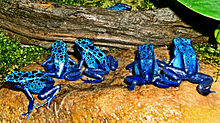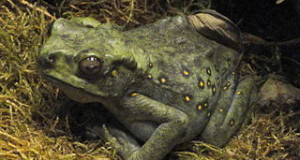General
 I have always found Marine Toads to be among the most engaging of amphibian pets. Toads in general seem to be (externally at least) more responsive than frogs- they “watch” everything, and appear to deliberately consider their next move. Protected as they are by powerful skin toxins, Marine Toads in particular seem possessed of real “confidence” in captivity, and we can get to know them well if we take the time.
I have always found Marine Toads to be among the most engaging of amphibian pets. Toads in general seem to be (externally at least) more responsive than frogs- they “watch” everything, and appear to deliberately consider their next move. Protected as they are by powerful skin toxins, Marine Toads in particular seem possessed of real “confidence” in captivity, and we can get to know them well if we take the time.
Please see Marine Toads – Natural History for information on Marine Toads in the wild.
Enclosure and Physical Environment
Some Marine Toads grow quite large – to 10 inches, and even small individuals can be quite active and consequently need a large terrarium. An averaged-sized adult can be kept in a 30 gallon “long” aquarium – while a really large one or a pair will do best in a tank of 55-75 gallon capacity.
During warm weather, Marine Toads can be housed in secure outdoor enclosures as well. Insects lured by a small light or over-ripe fruit will supply your toads with important dietary variety.
Their enclosure should be topped by a screen cover secured by clamps and the substrate should be kept damp but not wet. Compressed Frog Moss, Fir and Sphagnum Moss Bedding and Reptile Cage Carpet all work well. Marine Toads have a tendency to swallow substrate when feeding – usually they pass this without incident, but tong-feed your animals or use a feeding bowl –prod- if you notice this happening frequently.
Despite being quite bold, Marine Toads require a hide-a way where they can get out of sight (Rock Den or Turtle Hut). Be sure to provide a cave for each of your toads, as animals that cluster in one shelter seem prone to fungal infections of the skin.
Marine Toads need to soak frequently, so always have a bowl of de-chlorinated water available. Be sure that small toads can exit the water bowl easily, as they are poor swimmers.
While small toads can be kept in planted exhibits, adults will mangle all but the sturdiest of plants (try Cast Iron Plants and Snake Plants). They will clamber about on smooth logs – just be sure that these are secured in place as these brutes are quite strong and may roll a log onto themselves or a tank-mate.
Light, Heat and Humidity
Marine Toads do not require UVB radiation, and so will get along with a regular fluorescent bulb. Use a low UVB output plant light if you keep live plants, as high levels may cause eye damage.
The terrarium should be maintained at 72-80 F. Marine Toads can tolerate much warmer conditions – I have uncovered them below boards at temperatures of 100 F – but such is stressful and should be avoided.
Despite being largely terrestrial, Marine Toads seem quite prone to desiccation – spray their terrarium each morning and keep a water bowl available at all times. They often defecate in the water bowl – be sure to clean this as soon as possible, lest they absorb ammonia and other toxins through their skin.
Feeding
Your pets should be given as much dietary variety as possible. I have observed wild Marine Toads consuming over 2 dozen insect species in a very short time, and other researchers have documented a huge range of prey items (please see Marine Toads – Natural History article).
The main portion of their diet should not be crickets, but rather a mix of earthworms (these can be used as the bulk of their diet if necessary), roaches, crickets, and waxworms. Silkworms and Tomato Hornworms, available via internet dealers, should be offered from time to time. I use super mealworms sparingly, but others have done so frequently without incident. I have found crayfish to be an important food item for a wide variety of creatures, including Marine Toads. I remove their claws, just to be on the safe side.
Adults fed a varied diet require a vitamin/mineral supplement only once each week at most. The food of growing animals should be supplemented 2-3 times weekly.
Check back Wednesday for the conclusion of Marine Toads as Pets.
 That Reptile Blog – Reptile, Amphibian and Exotic Pet Care and Information
That Reptile Blog – Reptile, Amphibian and Exotic Pet Care and Information




we just 2 of these toads and decided to keep them for our 2 two yr olds to admire from outside the tanl ovoiusly lol and this web site helped alot wit finding out wat to do to keep them thanx
Hello Amber, Frank Indiviglio here.
Thanks so much for taking the time to write in with your kind words; much appreciated.
Yes, keep the little guys out of the toad tank but otherwise marine/cane toads are a fine choice as they are large and bold. Very nice that you are introducing your children to them at such an early age.
Just to be on the safe side, please check out the CDC’s Guidelines concerning reptiles and amphibians pet safety in homes with young children. The comments concerning turtles are applicable to all reptiles and amphibians.
Good luck and please keep me posted.
Best regards, Frank Indiviglio.
Hi i was wondering if its safe and okay for my 7 year old to keep a cane toad for a pet we have one along with a ball Phyton and a house Rabbit everyone we know thinks we are crazy and its not safe to give this as a pet. He loves the toad and the toad often can be found on my sons stomache with him talking to the toad please tell me what you think. thanks Denise
Hello Denise, Frank Indiviglio here.
Thanks for your interest in our blog. It’s great to spark children’s interest in animals and concern for their welfare through pets, but there are some concerns. Much depends on the supervision you provide the child, and upon your doctor’s opinion (please see below).
Cane toads and most other amphibians produce skin toxins which can be dangerous if they enter the eyes, mouth or an open cut. The toxins linger on the hands and other surfaces and can be transferred elsewhere some time later if not removed via proper washing.
Most reptiles and amphibians carry Salmonella of one species or another as a normal part of their gut fauna. The bacteria are shed with feces and easily find their way onto the animals’ skin as they move about, and from there to people’s hands. Salmonella infections can be quite serious, especially for young, elderly or immune-compromised individuals.
Also, amphibians should be handled infrequently, and then only with wet hands. Handling removes the protective mucus coating and leave them open to attack by pathogens…cane toads appear quite sturdy, but this does apply to them as well.
The CDC recommends that reptiles and amphibians not be kept in households with children below the age of 5. As regards older children, the recommendations are that they be allowed access to pets only under adult supervision, and after consultation with one’s doctor and veterinarian. You can read more about the guidelines proposed by the CDC and the Association of Reptile and Amphibian Veterinarians in the article Preventing Salmonella Outbreaks in Your Home.
I commend you on starting your child down such an interesting path (it’s how I started)…just please follow up as suggested above.
Enjoy, Good luck and please keep me posted.
Best regards, Frank Indiviglio.
Hi Frank,
Great to find a website that tells how to take care of these little guys and not how to kill them. I have a cane toad that I aquired from an animal Expo and he is now 5inches long, kept in a 20gallon aquarium and I keep the Temp at around 75F. I wonder if it is normal for him to stay in one spot all day and not move? He puts his back into the cornor of the tank and squats low to the ground and he stays like this unless it is feeding time or he decides to go into his water bowl. He is the perfect imitation of a rock…is this normal? I am not sure if he is suppose to be more active than this and want to make sure I am giving my little guy the best care I can.
Thanks!
Do these toads in particular have toxins on their skin that kill fish? I’m thinking of making a fish and toad or frog tank. I think toads are cooler, but all the other ones eat or poison fish, so I was just wondering, could these guys mix with some fish? I would have land space for them if they’re not big on swimming.
Hello
Thanks for your interest. Toxins released in to the water under stress would kill fish. Also, toads tend to spend time in water when it is available, crashing around and stressing the fish, dragging moss and dirt into the water, etc. Even in large zoo exhibits, I’ve not been able to manage them together.
Fire bellied toads do well with fish in a large aquarium 1/2 filled with water and stocked with floating live or artificial plants, and some cork bark or a turtle ramp. If you add thick, upright driftwood, you can also keep several treefrog species. While almost all frogs have skin toxins, I’ve not experienced any problems with these.
Please let me know if you need further info and ideas.
Good luck, enjoy and please keep me posted.
Best regards, Frank Indiviglio.
Hi Frank love your post. I recently got a Marine Toad but temps have been on the lower side. I’m using 75w infra red basking lamp on a 3 ft 18 inch high terrarium but temperature is only reaching 23.4C during the day. Is this okay or will I need a higher wattage? Thanks
Hi Jason,
23-24 degrees C sould be just right for your marine toad. Just be sure that he isn’t getting too cool at night.
-Josh
Hi
I’m having some problems with my toad. I’ve had it treated for hookworms and farces have improved but toad isn’t feeding well but still maintaining a good body weight. I just have the one toad and is this possibility due to it not having any company?
Hey Jasonm –
Thanks for writing in. Toads are generally solitary, except during mating season, so I do not believe company is the issue. There are a few things you would want to rule out.
1. Are ideal temperatures being maintained? Typically a range of 72-80 degrees Fahrenheit is ideal for a Marine Cane Toad. Though tolerated, higher or lower temperatures can cause stress. You’ll also want to offer the ability for the toad to move out of the heated portion of the tank should it desire lower temperatures.
2. What is the diet you’re offering your toad? You’ll want to vary the diet as much as possible between various insects and earthworms (see article).
I would also take note of some of the additional habitat requirements in this article. Should they be out of alignment, it could easily affect your pet’s appetite and it’s overall health. Good luck!
That Pet Blog.
hello,
I’m from Guam and recently caught what I believe is a cane toad in one of my guppy breeding ponds. I wondering if he was eating my fish. Anyways, I see these toads hopping all over the road on most nights and most people here think they are a headache. I kept him overnight in a bucket and was going to put it in the jungle the next day. It seemed quite friendly towards me and doesn’t even try to hop away. I know they are poisonous so I’ve have not touched him. I started to wonder if I could try and tame him. I started looking up some info online and became quite interested in this toad. Many of the videos I’ve watched show them as quite social. I have everything I need to make a terrarium and was considering keeping him in an old aquarium 20gal but he seems much to large and I don’t think he’d have a lot of room to move around in. Would it be possible to keep him outside in a fenced off shaded area with a small pool of water?
Hello, I have acquired a cane toad as a pet about a month ago, and I now believe it is injured. I think it’s tongue may be damaged as it does not eat. At first I thought it was stress or something similar, but after thinking over several things it seems likely to me this is the problem.
This is a male cane toad, and when he attempts his release call it is not vocal. He tries to do it, but he makes no noise. He refuses to eat at all regardless of what insects I offer him. Also I noticed the one time he did eat he tried to grab the insects with his mouth and not his tongue.
Have you ever dealt with anything similar? I just started force feeding him and I can only see this as the way to feed him.